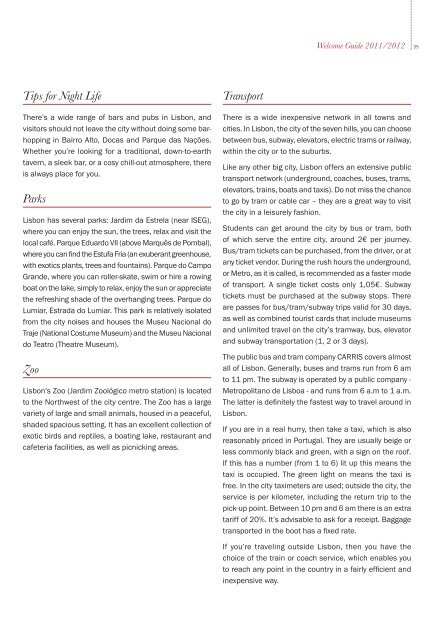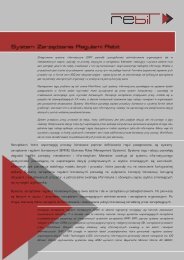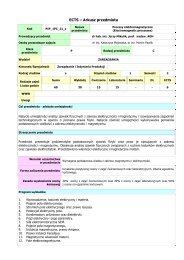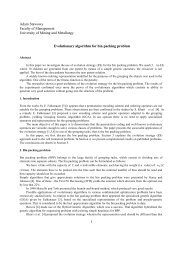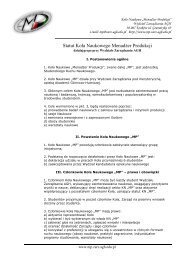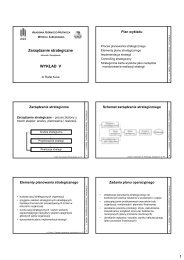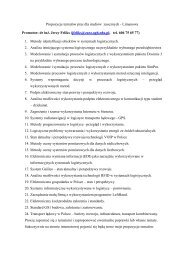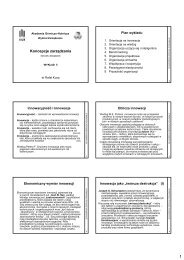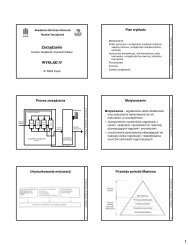Guide - Instituto Superior de Economia e Gestão
Guide - Instituto Superior de Economia e Gestão
Guide - Instituto Superior de Economia e Gestão
Create successful ePaper yourself
Turn your PDF publications into a flip-book with our unique Google optimized e-Paper software.
Welcome <strong>Gui<strong>de</strong></strong> 2011/2012 35<br />
Tips for Night Life<br />
There’s a wi<strong>de</strong> range of bars and pubs in Lisbon, and<br />
visitors should not leave the city without doing some barhopping<br />
in Bairro Alto, Docas and Parque das Nações.<br />
Whether you’re looking for a traditional, down-to-earth<br />
tavern, a sleek bar, or a cosy chill-out atmosphere, there<br />
is always place for you.<br />
Parks<br />
Lisbon has several parks: Jardim da Estrela (near ISEG),<br />
where you can enjoy the sun, the trees, relax and visit the<br />
local café. Parque Eduardo VII (above Marquês <strong>de</strong> Pombal),<br />
where you can find the Estufa Fria (an exuberant greenhouse,<br />
with exotics plants, trees and fountains). Parque do Campo<br />
Gran<strong>de</strong>, where you can roller-skate, swim or hire a rowing<br />
boat on the lake, simply to relax, enjoy the sun or appreciate<br />
the refreshing sha<strong>de</strong> of the overhanging trees. Parque do<br />
Lumiar, Estrada do Lumiar. This park is relatively isolated<br />
from the city noises and houses the Museu Nacional do<br />
Traje (National Costume Museum) and the Museu Nacional<br />
do Teatro (Theatre Museum).<br />
Zoo<br />
Lisbon’s Zoo (Jardim Zoológico metro station) is located<br />
to the Northwest of the city centre. The Zoo has a large<br />
variety of large and small animals, housed in a peaceful,<br />
sha<strong>de</strong>d spacious setting. It has an excellent collection of<br />
exotic birds and reptiles, a boating lake, restaurant and<br />
cafeteria facilities, as well as picnicking areas.<br />
Transport<br />
There is a wi<strong>de</strong> inexpensive network in all towns and<br />
cities. In Lisbon, the city of the seven hills, you can choose<br />
between bus, subway, elevators, electric trams or railway,<br />
within the city or to the suburbs.<br />
Like any other big city, Lisbon offers an extensive public<br />
transport network (un<strong>de</strong>rground, coaches, buses, trams,<br />
elevators, trains, boats and taxis). Do not miss the chance<br />
to go by tram or cable car – they are a great way to visit<br />
the city in a leisurely fashion.<br />
Stu<strong>de</strong>nts can get around the city by bus or tram, both<br />
of which serve the entire city, around 2€ per journey.<br />
Bus/tram tickets can be purchased, from the driver, or at<br />
any ticket vendor. During the rush hours the un<strong>de</strong>rground,<br />
or Metro, as it is called, is recommen<strong>de</strong>d as a faster mo<strong>de</strong><br />
of transport. A single ticket costs only 1,05€. Subway<br />
tickets must be purchased at the subway stops. There<br />
are passes for bus/tram/subway trips valid for 30 days,<br />
as well as combined tourist cards that inclu<strong>de</strong> museums<br />
and unlimited travel on the city’s tramway, bus, elevator<br />
and subway transportation (1, 2 or 3 days).<br />
The public bus and tram company CARRIS covers almost<br />
all of Lisbon. Generally, buses and trams run from 6 am<br />
to 11 pm. The subway is operated by a public company -<br />
Metropolitano <strong>de</strong> Lisboa - and runs from 6 a.m to 1 a.m.<br />
The latter is <strong>de</strong>finitely the fastest way to travel around in<br />
Lisbon.<br />
If you are in a real hurry, then take a taxi, which is also<br />
reasonably priced in Portugal. They are usually beige or<br />
less commonly black and green, with a sign on the roof.<br />
If this has a number (from 1 to 6) lit up this means the<br />
taxi is occupied. The green light on means the taxi is<br />
free. In the city taximeters are used; outsi<strong>de</strong> the city, the<br />
service is per kilometer, including the return trip to the<br />
pick-up point. Between 10 pm and 6 am there is an extra<br />
tariff of 20%. It’s advisable to ask for a receipt. Baggage<br />
transported in the boot has a fixed rate.<br />
If you’re traveling outsi<strong>de</strong> Lisbon, then you have the<br />
choice of the train or coach service, which enables you<br />
to reach any point in the country in a fairly efficient and<br />
inexpensive way.


